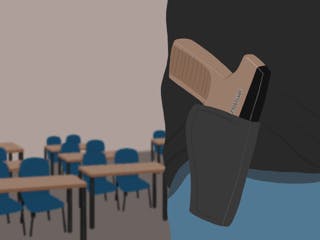Aron Bright stood around the corner from the locked door in classroom A202. Minutes before, the assistant principal’s voice had come over the intercom: lockdown.
As Bright remembers it, one student who’d stayed after school for help stood behind him. From the tone of the assistant principal’s voice, Bright knew this wasn’t a drill.
It was 2012. He had been waiting for the day an active shooter came to Avon High School. In his mind, it wasn’t if it happened. It was when.
Bright thought, “I don’t have my handgun.”
Empty handed, Bright wasn’t prepared for a gunfight. But he did have a plan.
If the gunman came to the classroom door, he would have to shatter the glass and reach through to unlock it. If it came to that, Bright said later, he was ready to rip the gunman’s arm off and feed it to him. He waited.
No one ever burst through his door. Later, he was told police had a tip that a former student was on the way to Avon High School with a gun, but they arrested him at home.
The next day, Dec. 14, 2012, a gunman killed 20 children and six adults at Sandy Hook Elementary School.
***
Bright, 48, teaches history in Avon, Indiana. In early February, he spoke to a committee of the Indiana House of Representatives to support arming teachers.

He told them about the time he was locked in his classroom, waiting for a gunman to burst through the door. He said for those 17 minutes, he was angry and defenseless.
“I could do things if someone stood at the classroom door of A202 with an AR-15 if I had my handgun that I can’t do without it,” Bright testified.
Teachers are not known for their ability to kill. They’re seen as shepherds rather than security guards. But with every school shooting whipping up fear, schools are under pressure to keep kids safe.
If it’s hard to picture a teacher with the nerve and skill to defend students in a hail of gunfire, then it’s useful to get to know Aron Bright. He’s a tough-talking dead shot who’s practiced under pressure. He’s also human, and he’s made mistakes. He still believes his students would be safer if he were armed in class.
Bright’s voice in the debate is lonely but resolute.
Bright testified to support House Bill 1253, which would allow schools to use state funds to provide 40.5 hours of firearms training to teachers, school staff and employees who volunteer and are authorized to arm themselves during the school day.
Two Indiana teachers unions opposed the bill. Representatives from both the Indiana State Teachers Association, which according to its website has nearly 40,000 members, and the American Federation of Teachers Indiana testified against it. Bright was the only teacher to testify in support of the bill.
In Indiana, it’s already legal for school districts to decide whether teachers can bring firearms into school. So far, three school districts allow some teachers or school staff to carry.
More districts may make the same decision if the bill is passed.
After Bright spoke, 21 more people testified. Four other teachers and an IU professor argued bringing more guns into schools would only create more opportunity for harm. Some said the funds proposed to be used for weapons training would be better spent placing police officers in schools or bolstering students’ mental health treatment.
To Bright, none of these arguments addresses what a teacher should do when face-to-face with a person determined to kill.
Suppose mental health programs didn’t help. Red flags were missed. The shooter got past school security. Police are on their way. The student resource officer is down the hall. A classroom of students is staring down the barrel. Now what?
***
On the range, with his gun in its holster, Aron Bright can get a shot off in less than a second. He doesn’t just carry one Smith & Wesson on his hip. He carries two.
His hair is buzzed short and he doesn’t know what brand of jeans he wears—“not a slave to fashion”. His phone doesn’t ring. When someone calls, an engine roars.

He grew up on a hog farm in Centerville, Indiana. Guns were around him, but Bright didn’t start shooting regularly until later in his life. To get away from farming, Bright became a teacher.
He teaches a United States history course to juniors at Avon High School and is in his 25th year as a teacher.
Bright tells it like it is, said Catherine Trinkle, an instructional coach who observes classes to give feedback to teachers. She said he uses questioning to get his students to approach topics more deeply.
Bright calls himself old-school. He likes to lecture and isn’t big on group work. He said he wants his students to not only tell him their opinions, but to back up those opinions with historical facts.
His teaching goes beyond U.S. history, however. He has been a firearms instructor since 2008. Bright teaches at Parabellum Firearms and Indoor Range in Avon and owns a private gun training business, Bright Firearms Training.
Bright taught an advanced group of shooters Feb. 18 at Parabellum. The group of five ran drills practicing shot speed, shooting with their weak hand and shooting while moving.
While shell casings rained, Bright paced and watched. His commands were strong and loud enough to be heard through protective ear muffs.
Above all else, Bright preached safety, telling the group if someone pointed a gun at another person, even if it was empty, they were done for the night.
The men shot for more than two hours. The hollow shells falling to the concrete sounded like wind chimes.
***
Emily Cole, a senior at Noblesville High School, testified against House Bill 1253 the same day as Bright. During her testimony, she spoke directly to Rep. Chuck Goodrich, a Republican from Noblesville.
She told Goodrich she sat in front of his daughter at school when a student at Noblesville West Middle School shot two people in May 2018. She said they held hands and cried together.
“This bill would have only increased tensions that day,” she said.
Guns are inherently dangerous, Bright said. That’s something he stresses when teaching gun safety. Even if there is no magazine in the gun and he can see that the chamber is empty, he said he still treats the gun as if it’s loaded. That’s one of the first lessons any shooter learns in training.
Bright agreed that there are legitimate concerns to having guns in schools, such as accidental misfires during normal days or poor accuracy in the event of a school shooting, but that doesn’t mean there's a better solution.
Safety issues can be mitigated not only through proper training, he said, but by letting people who don’t want to be armed stay unarmed.
***
For years, Bright coached wrestling at Avon.
Wrestling has been a part of Bright’s life since middle school, and the lessons the sport has taught him inform his perspective on self-defense. He said it’s part of the reason he decided to take up shooting.
At a national tournament in 1992, Bright, wrestling for Manchester College, now known as Manchester University, faced Tom Moore, a wrestler from West Virginia. Bright had suffered many losses and a set of broken ribs to Moore in the past, and this time, he lost to him again. Moore went on to lose in the tournament to another wrestler, and Bright recognized that no matter how strong or fast he was, someone would always be stronger or faster.
“I've had Tom Moore kick my ass a few dozen times and then I watched him get treated like a child,” Bright said. “I decided out here in the real world where there ain't a referee to save you, I'm probably going to need some help.”
Adrian Panko is a former Avon High wrestler who graduated in 2001. He said Bright taught him to be tough and work well under pressure.
Panko supports arming teachers and said he would have trusted Bright to carry a firearm at school when he was a student. He said as a teacher and coach, Bright was committed to his success.
That commitment became clear to Panko during a freestyle wrestling meet, he said. During one of his matches, the fight started to get dirty.
He won the match, but in the hallway afterward, the player’s father confronted him, Panko said.
He said the man cursed at him and reached for him, but Bright intervened. Bright came at the man like an offensive lineman, Panko said, sending him careening toward the lockers where Bright pinned him. He said the man was escorted out of the building.
Bright’s coaching career at Avon ended in 2002. He was suspended after biting the head off of a live sparrow in front of his wrestlers as a motivational tactic before a tournament.
The story was picked up by national news outlets. He explained back then that in the country, where he grew up and where the incident happened, sparrows are varmints. The bird didn’t suffer and neither did his team, he said. But it was still a bad idea.
He chose to resign as coach because the incident was the only thing people wanted to talk about, he said in February.
“It was the right intentions," Bright said. "It was the wrong thing to do. It was unprofessional, it was stupid and what it did was it cost me in a big way.”
***
Jenny Bivans, a retired elementary teacher, testified against the firearms training bill the same day Bright testified. She said the teachers she knows would take a bullet for their students.
The hundreds she knows aren’t trained to kill, she said, and they don’t want to be.
“Educators are wired to be helpers, nurturers, mentors and role models to their students,” Bivans said. “Police officers are wired to confront school shooters.”
Bivans has two granddaughters in elementary school. She knows the police officer posted at the their school in Zionsville, Indiana. She said she doesn’t know why student resource officers like Officer Sam aren’t the answer.
During his opening testimony, Rep. Jim Lucas, the author of House Bill 1253, argued that with the funds proposed to be used by the bill, a school could train 45 teachers to use firearms. The Seymour Republican said having just one resource officer costs around $70,000 annually.
The bill passed the Indiana House education committee that Bright and the other teachers testified in front of. Since then, it has passed a second and third reading and been referred to the Senate to be voted on.
If passed, the bill will return to the House to be approved before it’s seen by the governor.
Supporters of the bill could still argue that arming teachers is the last defense when a gunman is standing in the doorway.
Ann Herron, a retired teacher, also testified against the bill. In an interview, she said in her 23 years teaching, she never had to face a gunman in school. She resists the idea that teachers would be the last line of defense in a school shooting.
“If that is really the only true solution to this, then I wouldn’t be able to teach,” Herron said.
***
The lights were out in the indoor shooting range. Jerry Hillenburg, 68, stood in the dark.
Bright had set up the range to simulate a home intrusion. One at a time, Hillenburg and the other marksmen had to defend their homes from the paper and wood robbers with just a handgun and flashlight.
“Up!” Bright yelled.
Hillenburg drew his gun from his holster and flicked on his flashlight. In the light were two boxy wooden men holding handguns, surrounding an innocent man holding a black phone. Hillenburg assessed the situation. He paused. He fired his gun. He paused. He fired three more rounds.
He repeated the process on the second scenario and made his way down to the third.
"Now, this target sucks ass,” Bright told Hillenburg. “I'm going to give you a hint. This is a hostage situation.”
“OK,” Hillenburg said.
“One gets shot, one doesn't," Bright said. “Up.”
Hillenburg drew his gun and turned his flashlight on. Six seconds passed. Bang. Four more seconds. Bang. He holstered his gun.
When the lights came on, Hillenburg had done well on every scenario but the hostage. The first bullet hit the hostage in the corner of the eye. The second, Bright told Hillenburg, hit the brainstem.
“He’s done,” Bright said. “That’s a tough shot.”




